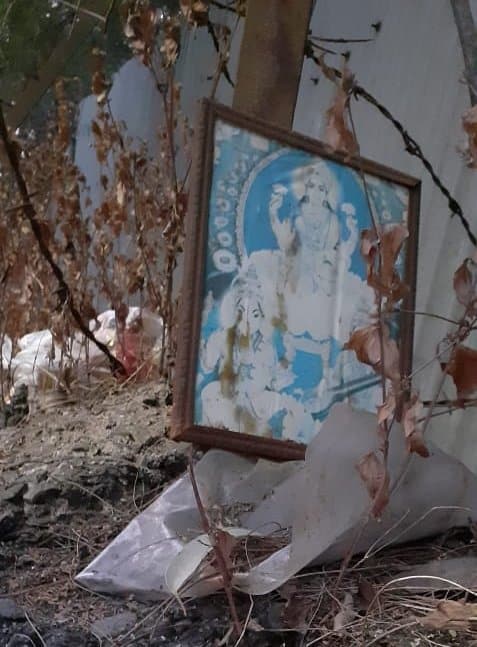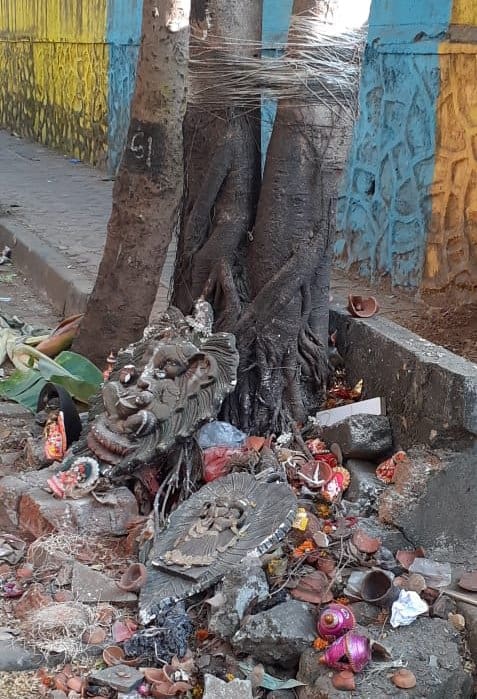I love the smell of the morning air and the quiet that allows the chirping of the birds to filter through. A morning walk is the best way to start the day “they” say. Exercising in the morning is good for the body’s metabolism, makes you feel happy and energised, and ensures that you’ve got the exercise you need before you get busy with your daily chores. However, over the last few years, I return home after my morning walk, very disturbed by some of the sights around the neighbourhood.
Statues and pictures of Gods and Goddesses, lie abandoned under trees and in garbage piles. Some are just like new, in tip top condition while others are a bit weathered. Some have obviously got damaged after they were thrown to the mercy of the elements. This happens through the year, but seems to peak after the festival season, post Diwali.



I always ask myself the same question: What goes on in peoples’ minds when they throw away these beautiful statues and pictures – things that have been a part of their lives, family and home? Gods whom they worshipped for days now lie on the side of the road among other bags of garbage, thrown like broken toys. This is a tough pill for anyone with faith to swallow. I can’t imagine doing the same things with the remains of our loved ones who have passed on. Is our God any different?



While I do realise that these statues and pictures are merely a representation of the power we believe to be above us all, we still go out to buy them. We use them for decoration in our homes and temples. We use them as an opportunity to show respect to God, garlanding and worshipping them, touching their feet, asking them to bless us. Sometimes I wonder if people think that they lose their power in any way after the rituals are over or they become old.

In the tradition practised in North India, old or broken statues are deposited near a flowing water source and they disintegrate becoming one with the earth. However this is something that can be done only if the statues are ecofriendly. These days we can’t really be sure of the material and the paints. Moreover, we have reached a stage when we should be minimising what we discard, for the sake of the environment.
I’ve seen many good citizens who share the same concerns as I do. Some of them buy statues made of natural materials and then bury them in soil, which is quick and respectful. There are others who rescue the abandoned statues from the roads, cleaning and fixing them to be used as show pieces. Most of the picture frames that are thrown can be reused.
I have now totally stopped buying new statues. I enjoy cleaning and worshipping the ones that I already have, and trust me, it doesn’t make any difference. I hope that many more will think about doing the same. And having expressed my pain, I hope my morning walks will be less disturbing.
Also read:
I absolutely agree with the topic and the same question arises “what goes on in people’s minds when they throw away the God icons and the road and expect blessing in return.”
I absolutely agree with the topic and the same question arises “what goes on in people’s minds when they throw away the God icons on the road and expect blessing in return.”
I completely agree with it
Very good thoughts Rajni.
Dear Ms. Rajni
Heartiest Greetings ?
I have gone through the Article.
Very Thoughtfully Written and after reading gone through the same intensity of Pain as U have felt.
Ofcourse the Solution lies with Us only and can be discussed. Regards
I fully agree with writer Rajni. But you can’t deny the fact that sometimes statues or photos are due for absolute replacement after long period. In such situation, you don’t have any option than buying new one and discarding used one. So we can’t avoid this situations. Hence there should be some place allocated for discarding such type of statues, photos, idols etc. Where people can deposit the old idols, statues etc. Since there is no places people are exercising their own options.
Agreed, we r thinking about this problem that there should be a place where we can do visarjan of old statues, soon will get answer.
Very well written article Rajni, I’ve noticed people do this mostly either when the pictures or idols have become old or if they’re broken (they call it Khandit moorti). The right way to do this is like you mentioned in your article, to repaint it or redesign it, or to discard it the right way.
It’s common sense just but handled senselessly.
Superb mam??
Very well written. Totally agree. We all should behave responsibly and generate minimum waste possible. Recycle, Reuse and Reduce.
Very nicely written and expressed by you Rajni.
Very very nicely written… It’s good to see someone who finally raised this issue… Respect.